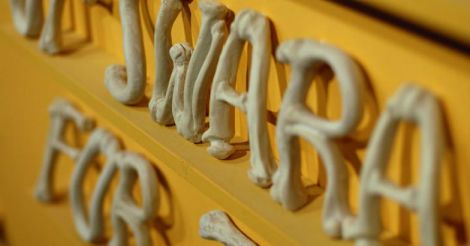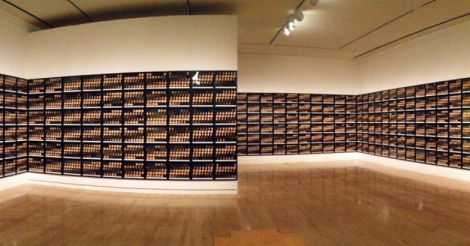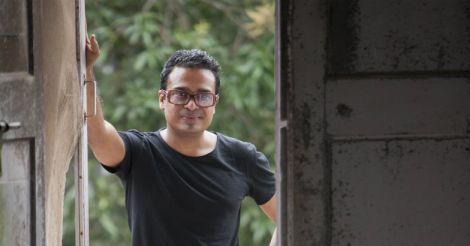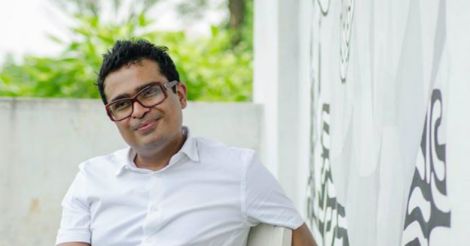Bombay-based artist Jitish Kallat is the curator and artistic director of the Kochi-Muziris Biennale 2014. In this interview with Onmanorama, Jitish shares his views on a handful of topics, including the experience of being an artist-curator, the state of Indian art schools and his idea of art.
Can you briefly reflect on the figure of the curator in the contemporary art world?
In the last two decades the figure of the curator has emerged as a key mediator between artist, exhibition site and audience. Like art-history, curatorial practice has evolved its own form of narration and a supple vocabulary through the tools of exhibition-making. If art-history focuses on art that has already happened, curating attends to art as it happens.
 A view of Jitish's ’Public Notice 2’ (2007)
A view of Jitish's ’Public Notice 2’ (2007)What is your take on the importance of an artist being a curator?
I think one interesting aspect, purely from the process perspective, is that when you are an artists you work in silence, asking your questions to yourself. But if you are an artist-curator, you extend the dialogue with 95 colleagues. And to me that’s been a primary shift. To interrogate the world with conversations rather than through a solitary process. Yeah that’s what I would primarily say about it. I would not make a big thing about an artist-curator. That’s not for me to say it. (laughs).
Have you had an idea of what KMB-14 should be before you started working on it? And if there was any, how far could you reach there?
In a very interesting and uncanny way, I continued to proceed in a way that I didn’t want to have preconceptions about what the Kochi-Muziris Biennale-14 should be. I didn’t want to begin with a preconception of what the end result of the Biennale should be. But in an uncanny way, now that it has been realised, it seems something of this, not exactly in a zig-zag way, was lurking in my mind’s vision pretty much early on. But in every stage my process really was to let the Biennale emerge through a very strategic set of gestures mostly through an elaborate letter writing process. So that the Biennale develops not out of a super imposition of a single theme but through an infiltration of intuitions amongst all the practitioners, all the artists. So that through a clue of intuitions a person viewing the Biennale can see ideas and themes recur in different places. So the Biennale gets formed in the mind of the viewer at the end of viewing it.
 Jitish's 'Epilogue'
Jitish's 'Epilogue' What is the research and selection process you followed? How do you arrive at the artists and works to be featured in the Biennale?
I began with a small, core group of artists whose work for me became the nucleus of the project. Thereafter, the process of inviting artists has been primarily one of responding to the biology of the project, which is a shifting field and every invitation greatly alters this constellation of signs. It entailed six months of incessant travel and dialogue with artists and scholars in various places around the world. The Biennale is a snapshot of a journey in a sea of possibilities
It has been almost one month since the show opened. Viewers’ response?
There has been some fantastic reviews about mutual arts and so on. That apart, to me what’s interesting is that I had hoped that the Biennale at this large scale can still relate to the viewer in such a way that moving from project to project the ideas start to grow and overlap and reemerge. And what’s been interesting to me was to get feedbacks from so many curators and artists and even the general audience that when they finish the whole projects it all starts falling to place. So rather than being one linear process or one linear track of ideas, various ideas come together and cross-pollinate perhaps even after you finish seeing the whole projects. So, for me it was important that the Biennale develops what I call a self-generated organising principle from the project itself. It begins to develop itself in your thinking.
You mentione general audience. It can still be debated but, there are at least two types of audience. One includes the people who are into arts and thet other the general audience?. Do you think Biennale is a space where the two converge?
In fact, the public is also of many types. I don’t think there are only two. I'm very optimistic about, I would not use the word general public, the response of local communities of Kochi. I think the lack of exposure to contemporary art is compensated in many ways by their engagement in social, cultural and political processes as members of a civil society. I think they bring a lot of those experiences to the viewing of art which is a differently enriched view. You can have all the art history in your head but if you are just walking through an artwork, it’s of no use. And to me its valuable that somebody can spend ten minutes in front of each Michael Stevenson’s video. And the guy has an American or British accent. To me it’s interesting that people are able to sit through long videos and commit their time to it. So your commitment as a member of civil society and your ability to commit time to an artwork are possibly as valuable, if not sometime more valuable than all the art history that you can bring to it.
 'Death Of Distance' by Jitish Kallat on display
'Death Of Distance' by Jitish Kallat on displaySo Biennale is a space where such a knowledge can be created?
I think the Biennale is, and I have used two terms and I used them somewhat thoughtfully. I wanted this Biennale, perhaps if you draw an analogy, to be an observation deck to the world or a tool box to view the self. And they are the same thing actually, the world and the self are not too far apart. But to me it’s not essentially to be viewed as an exhibition alone but essentially as a viewing device. You can actually think about your self and your world through the Biennale. The Biennale becomes a viewing devise, not the thing to be looked at alone and also something that can look through.
Do you find any trend in current art scene?
There isn’t really a trend. You can't really define an entire art scene by any one kind of definition, especially at this point. This is the point when in all the disciplines other disciplines enter and interact. Art is one space where that happens a lot. Contemporary art could draw upon just about anything right from caricature to science fiction to spiritual wisdom traditions to humour to returning to old forms of drawing on palm leaves. You could do any of these. It’ll still be art.

Can we say that the realm of Indian art is undergoing a transition?
I don’t think it’s India or global. Today, the world is so inter-related that I don’t know if we can create artificial boundaries. You can talk about art scene or so on but you cannot talk about Indian art as something separate from other arts. It will be a very difficult proposition to make a serious definition. You can make comments. But that wont be legitimate. The breaching of boundaries go back 40-50 or 60 years ago and it has its roots in a global framework where say artists such as Marcel Duchamp placed ready-made objects into the domain of art. And I think since that moment it’s been redefined and re-purposed by artists all over the world in a very distinctly different ways.
The very idea of an installation was something new to Kerala during the first edition of KMB?
Like I said, it has its legacy of some 30 or 40 years. There wasn’t a venue or the possibility of some of them to be seen in Kochi. But I think what’s interesting is that the people have been pretty receptive of allowing themselves to participate in different modes of viewing. For instance, a four-channel video is a complete reinvention of the way in which you watch videos because you don’t know which screen to look at. You can only watch in one direction. But if you observe the audience they have nicely adjusted to the demands of different kinds of viewing with a four-channel video installation. I think it’s been very interesting to look at that transition. It has, kind of, reinvented your way of looking at things.
This time, we have a Student Biennale which aims at encouraging talents in the making. How do you look at the art schools in India?
The state of both our art institutions and cultural institutions are equally in a terrible stage of disarray. That’s at the level of art education and also at the level of institutional viewing of art which is the state-run academies or museum that we have all over India. Both of these need tremendous reinvention. Still what’s interesting is that if we look at the art scene we will find many examples of individuals who have emerged from the system completely untouched by its lethargy. They came out afresh and invigorated from dead systems. There is still an emerging generation of artists coming alive from dead systems. But of course the system needs a total reset.
Our institutions lack an inter-disciplinary approach which is a current practice across disciplines?
The problem for me is more about the degree of what one may call an inquisitive quotient of an institution. How inquisitive is an institution is the problem. It’s not about the material. What the institutions should do is to develop a deep sense of inquiry that is missing. It’s not whether you later pick up a pencil to do something on paper or you want to use advanced technology. At the level of insight possible in both the media are same but it’s about what the depth of your enquiry. The medium is irrelevant. It’s all about at the core how do you function. Like, what are your questions or why do you live? These questions are not asked to students. Imagine on the first day of your school, your teacher asking you these questions instead of asking you to draw. That will change the texture of your day. It will change what you do in your day and the way you commit yourself to people, but that’s missing. It's like you being taught some basic skills to render the world without actually interrogating why you exist in the world. The tree that you drew is irrelevant until you realise that there is something else between you and the tree and what are the transactions between you and the tree.
Do you think only a work resulted in such an enquiry is able to evoke the same enquiry in a viewer?
I think so. It doesn’t mean that you have to have those questions in the work. But if it’s in the bloodstream of your actions in the world, it appears in the work without being in the work. I think that’s where great art comes from.
It's a known fact that the Biennale Foundation had to face a lot of hardships to render this edition. Do you wish to talk about it?
See, the degree of optimism of the team and the resilience to overcome challenges is in inverse proportion to resources which is why the Biennale is happening. The Biennale is working with mounting debt. So at some point the Kerala government will have to help the Biennale Foundation to overcome it.
People say art cannot survive without patronage. Do you think so?
Art as a human action will survive anyway. Art as a human effort will find its manifestations. Even if you put someone in a prison, he will draw and you cannot stop it. But art as a discipline needs to develop with the help of patronage. They are two different things. It’s a discipline held together by many elements and patronage is one among them.

It becomes problematic as sometimes art will have to succumb to such patrons whom it opposes?
It's sometimes an interesting part that art can exercise its voice with the amplifications from the systems that it questions. Art might question the system from within the system.
One of the current trends is the mixing up of various media and there are people who object to it. What's your idea of art?
That argument has no steam. What’s pure art? The beauty of everything is in intermingling and cross pollination. Art is confluential in nature. It’s probably one of the forms of knowledge that survives through confluence. If I’m sensitive enough, every moment of my life I will see myself at the confluence of energy and experiences just by being there. And art is a way of manifesting that confluence.
There were and are criticism that mega events such as Biennale are often apolitical. Comment?
I believe that self-reflection is a political act. I was keen that politics (if one might call it that) does not end or begin at a placard, but makes its case by interrogating deeper levels of our existence. “Whorled Explorations” conducts its inquiries by paralleling investigating the very limits of our perceptions.











































 Jitish Kallat. (Photo courtesy Facebook)
Jitish Kallat. (Photo courtesy Facebook)
Disclaimer
The comments posted here/below/in the given space are not on behalf of Manorama. The person posting the comment will be in sole ownership of its responsibility. According to the central government's IT rules, obscene or offensive statement made against a person, religion, community or nation is a punishable offense, and legal action would be taken against people who indulge in such activities.